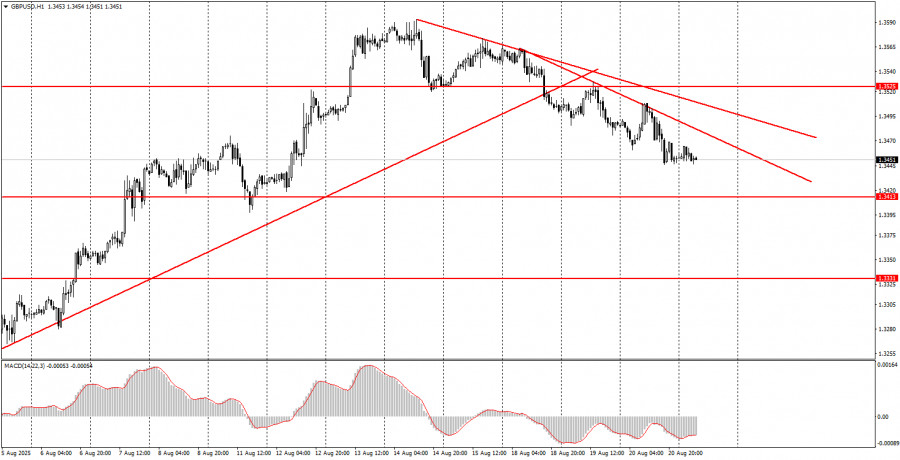Analysis of Wednesday's Trades
1H Chart of GBP/USD
On Wednesday, the GBP/USD pair continued a weak downward movement, which is based purely on technical factors. While there was no macroeconomic background on Monday and Tuesday, on Wednesday, the UK published an important and fairly significant inflation report. The Consumer Price Index rose in July and has now been increasing for 10 consecutive months. Moreover, it usually grows at a faster pace than experts forecast. Since inflation in the UK continues to rise, this significantly reduces the likelihood of a fourth stage of monetary policy easing by the Bank of England in 2025. For the British currency, this factor serves as support. However, the market did not manage—or perhaps did not want—to resume the upward trend yesterday. Two descending trendlines have been formed, and overcoming them would indicate the completion of a purely technical correction.
5M Chart of GBP/USD
On the 5-minute timeframe on Wednesday, three trading signals were formed. Since the pound is still showing at least some movement, there was an opportunity to try to trade it. However, volatility in the British pound remains very low. Therefore, while signals were clear, the strength of the movement was insufficient to secure profit. Yesterday, the price bounced twice from the 1.3466–1.3475 area and broke through it once. Each time, the movement in the intended direction amounted to 20–25 pips.
Trading Strategy for Thursday:
On the hourly timeframe, GBP/USD shows that the short-term downward trend persists. We believe this is merely another correction, since the fundamental and macroeconomic background has not recently become more favorable for the dollar. As there will be very few macroeconomic and fundamental events this week, trading can be based on the technical picture. We still do not expect a significant drop in the pair.
On Thursday, GBP/USD may resume upward movement, as the correction could end at any moment. Trading (if desired, given the current volatility) can be considered from the 1.3466–1.3475 area.
On the 5-minute timeframe, levels currently suitable for trading are 1.3102–1.3107, 1.3203–1.3211, 1.3259, 1.3329–1.3331, 1.3413–1.3421, 1.3466–1.3475, 1.3518–1.3532, 1.3574–1.3590, 1.3643–1.3652, 1.3682, 1.3763. For Thursday, the UK and the U.S. are scheduled to publish business activity indices in the services and manufacturing sectors. However, yesterday we saw an extremely weak market reaction even to a much more significant report—inflation. The technical trend remains, and low market volatility also persists.
Core Trading System Rules:
- Signal Strength: The shorter the time it takes for a signal to form (a rebound or breakout), the stronger the signal.
- False Signals: If two or more trades near a level result in false signals, subsequent signals from that level should be ignored.
- Flat Markets: In flat conditions, pairs may generate many false signals or none at all. It's better to stop trading at the first signs of a flat market.
- Trading Hours: Open trades between the start of the European session and the middle of the US session, then manually close all trades.
- MACD Signals: On the hourly timeframe, trade MACD signals only during periods of good volatility and a clear trend confirmed by trendlines or trend channels.
- Close Levels: If two levels are too close (5–20 pips apart), treat them as a support or resistance zone.
- Stop Loss: Set a Stop Loss to breakeven after the price moves 20 pips in the desired direction.
Key Chart Elements:
Support and Resistance Levels: These are target levels for opening or closing positions and can also serve as points for placing Take Profit orders.
Red Lines: Channels or trendlines indicating the current trend and the preferred direction for trading.
MACD Indicator (14,22,3): A histogram and signal line used as a supplementary source of trading signals.
Important Events and Reports: Found in the economic calendar, these can heavily influence price movements. Exercise caution or exit the market during their release to avoid sharp reversals.
Forex trading beginners should remember that not every trade will be profitable. Developing a clear strategy and practicing proper money management are essential for long-term trading success.













